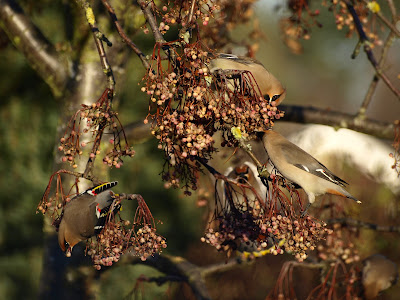 Waxwings have continued to entertain many birders and non-birders during the first few weeks of 2011. Although the larger flocks have now headed to the south of the country and over the channel to mainland Europe there are still small numbers scattered all over the UK. After many weeks of trying to track down birds in and around Shrewsbury, and only managing a brief distant view of 17 birds from my study (right), I was lucky enough to catch up with a small flock in the east of town.
Waxwings have continued to entertain many birders and non-birders during the first few weeks of 2011. Although the larger flocks have now headed to the south of the country and over the channel to mainland Europe there are still small numbers scattered all over the UK. After many weeks of trying to track down birds in and around Shrewsbury, and only managing a brief distant view of 17 birds from my study (right), I was lucky enough to catch up with a small flock in the east of town. Up to 31 birds were present in trees in a quiet residential area, an unusually pleasant area for Waxwings that are usually found in retail parks, along road verges and a few weeks earlier on a roundabout along the A5! The sun was out and the birds gave cracking views as they came down to feed on a single Rowan tree in a front garden.
Favoured perching tree prior to flying down to berries on a Rowan
Feeding frenzy
The breeze played havoc with their hair styles!
 After reviewing a couple of shots on the cameras LCD screen I realised there was one Waxwing with a number of rings on its legs. A quick search on the web when I returned home revealed that the white ring and standard metal ring on the right leg indicated it was a bird ringed by the Grampian Ringing Group so I sent them an email with the combination of three coloured rings on the left leg. A quick response showed the Waxwing was a 3rd year male ringed in Aboyne, near Aberdeen in early November and subsequently seen by another birder in Manchester at the end of November.
After reviewing a couple of shots on the cameras LCD screen I realised there was one Waxwing with a number of rings on its legs. A quick search on the web when I returned home revealed that the white ring and standard metal ring on the right leg indicated it was a bird ringed by the Grampian Ringing Group so I sent them an email with the combination of three coloured rings on the left leg. A quick response showed the Waxwing was a 3rd year male ringed in Aboyne, near Aberdeen in early November and subsequently seen by another birder in Manchester at the end of November. Ringing provides interesting and valuable information on bird movements so keep an eye out for ringed birds when looking at flocks of Waxwings and other species. More information can be found by following the links below:






